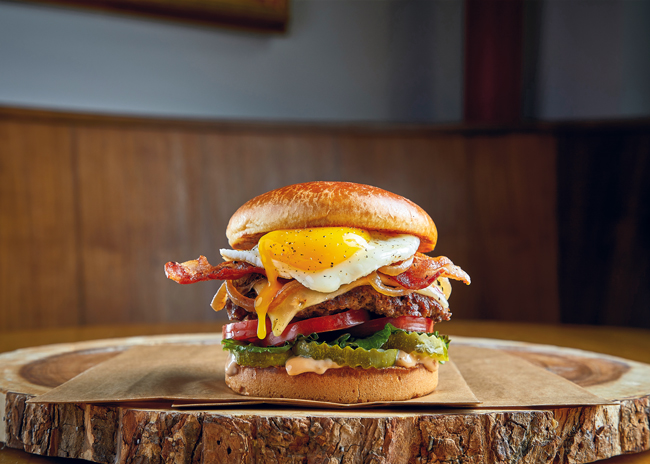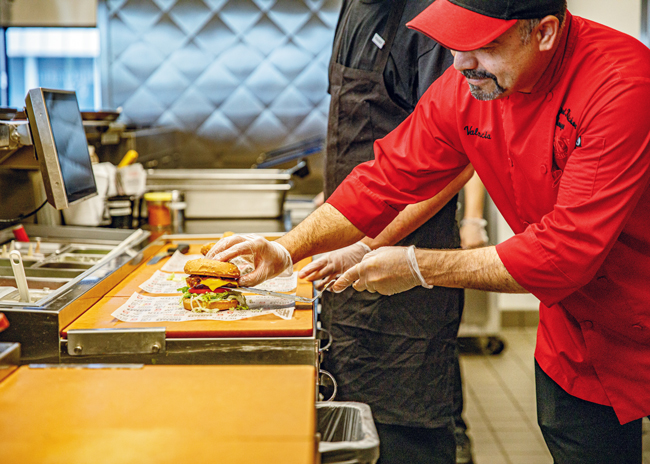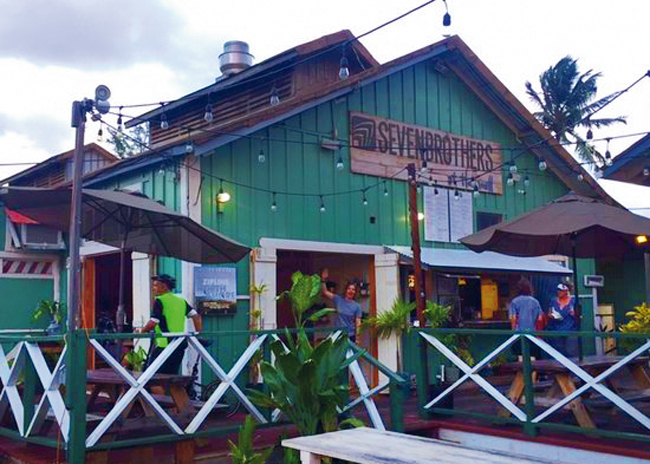Burgers remain a menu mainstay. What’s changed is cooking techniques, flavor combination trends and restaurant square footage.
 Epic Burger’s Farmhouse BurgerWhen it comes to restaurant dishes, few can claim menu status at casual quick-serves, fancy sit-down restaurants and everywhere in between. Burgers, if you will, are the little black dress of restaurants. Whether they’re adorned simply with cheese, lettuce and tomato and wrapped in paper or gussied up with escargot butter and served on fine china, burgers remain culinary crowd-pleasers like no other.
Epic Burger’s Farmhouse BurgerWhen it comes to restaurant dishes, few can claim menu status at casual quick-serves, fancy sit-down restaurants and everywhere in between. Burgers, if you will, are the little black dress of restaurants. Whether they’re adorned simply with cheese, lettuce and tomato and wrapped in paper or gussied up with escargot butter and served on fine china, burgers remain culinary crowd-pleasers like no other.
But even this menu mainstay needs to evolve to keep up with the changing tastes and demands — veggie burgers, anyone? — of discerning diners, to say nothing of the rising costs of, well, everything. For some restaurant owners, that means leaning into their brand values even more. For others, it requires expanding their menus beyond burgers to ensure that those who aren’t lovers of the classic American sandwich feel welcome. And then there are plenty who are doing both.
While smash burgers seem to be everywhere these days, fast-casual concept Epic Burger has used that cooking technique since it opened its first location in Chicago in 2008. “The way we prepare our burgers makes them so much more flavorful,” says David Grossman, CEO/founder. The company now has eight locations in Illinois with three more scheduled to open by fall 2024.
With a tagline of “a more mindful burger,” Epic focuses on utilizing premium ingredients, including certified-halal Black Angus beef and brioche buns baked daily, and incorporating sustainable practices, such as sourcing from local purveyors as much as possible. While the price of goods has gone up, Grossman’s commitment to high-quality products hasn’t wavered. “We’re not the cheapest restaurant on the block, but you get what you pay for,” he says.
One area that has changed is the menu. Turkey burgers were added shortly after opening, with grilled chicken sandwiches a little while after. Plant-based burgers, gluten-free buns and a Nashville-style hot fried chicken sandwich followed. Regulars know that off-menu items, such as grilled cheese and lettuce wraps, are there for the asking. “Diets change, and everybody wants something different,” says Grossman. “You don’t want to have a reason for people not to come.”
But change does come with storage challenges for Epic’s 2,000-square-foot locations. “We’ve debated about doing a 32-ounce fountain drink for our drive-thru, which would mean adding another cup and lid. It sounds insignificant, but it takes up space,” says Grossman. The recent addition of chicken fingers to the permanent menu meant buying small refrigerators to store them separately to prevent cross-contamination.
Limited-time offers (LTOs) represent another area of Epic experimentation. Recent offers have included a riff on a Chicago hot dog as well as a fish sandwich during Lent. Last summer’s Italian beef burger paid homage to the hit television show “The Bear,” which films in Chicago. “We’ve tried to get fancy with things like bacon jam and crispy shallots, but sometimes when you get too fancy and too creative, you alienate the masses, so we try to stick to the basics,” says Grossman.
Basic also applies to Epic’s back-of-the-house equipment, which includes a flattop grill, fryers, refrigerated drawers and bun toasters. A heavy, rectangle-shaped stainless-steel press is used to smash the burgers. “Epic is a pretty simple operation, which I love,” says Grossman.
Technology-wise, Grossman is looking into self-ordering kiosks, although Epic’s cashiers aren’t going anywhere. “We’re in the hospitality business, so welcoming people with a smile and providing great customer service is our job,” he says. “You can’t do that with a self-order kiosk, but it’s nice to give people the option.”
 The Calif.-based chain prides itself on its cooked-to-order philosophy, eschewing heat lamps, microwaves and cubbies to store food.
The Calif.-based chain prides itself on its cooked-to-order philosophy, eschewing heat lamps, microwaves and cubbies to store food.
California Cool Burgers
The Habit Burger Grill, a California-based burger-centric fast-casual, opened in 1969 with a small shop in Santa Barbara. Since then, it has grown to more than 350 locations in 14 states as well as 12 international restaurants. “Over the past five years, the burger segment has leaped into the future,” says Joaquin Soto, senior director of restaurant excellence, referencing ordering ahead and home delivery as two ways the segment has been transformed. “Many businesses that were designed to deliver an in-restaurant experience have had to rethink their footprint and deployment of labor. This has really challenged operators to reevaluate what customers value most.”
Like Epic, Habit prides itself on using top ingredients, which include never-frozen 100% ground beef for its made-to-order burgers. Here, however, chargrilling represents the cooking technique of choice. “We firmly believe cooking fresh, quality ingredients over an open flame is the only way to do it,” says Soto.
Additionally, Habit takes pride in what it doesn’t have. “We don’t have heat lamps, microwaves or little cubbies to store our food,” Soto says. “It’s not the easiest way to operate a restaurant, but it certainly is the best-tasting way to cook.”
Over the years, Habit has moved beyond its original burger-and-shake concept to offer a chargrilled chicken club on toasted sourdough, salads and a sushi-grade ahi tuna sandwich. “It is an unexpected menu item from a ‘burger place,’ but it’s delicious,” says Soto.
By already having its existing POS and kitchen display system integrated with third-party ordering, Habit was able to quickly pivot during the pandemic, says Soto. Additionally, its marketing department had the benefit of working with its delivery providers to better understand the behavior of its consumers. Habit’s tech team constantly stays on top of ways to enhance its ability to prioritize the best channels to build sales. “With more and more orders placed digitally, the industry is left wondering how to deliver hospitality in this new operating environment,” says Soto.
Automation is an area Soto has his eye on, especially for things like self-cleaning, auto-lifting fryers with robotic arms. “There is a level of automation that can make the unpleasant or most challenging tasks simpler,” he says. Generative AI that could be used for decision-making in forecasting, scheduling, ordering and prep is on his radar too. “At a higher level, using AI to complete analysis and help gain insight could really help brands better understand how to maximize efficiency and profitability,” he says. “That would be a game changer.”
 The first location of Seven Brothers Burgers in Kahuku, Oahu.
The first location of Seven Brothers Burgers in Kahuku, Oahu.
Family Fun
Founded in 2009 and franchising since 2022, Hawaiian-born Seven Brothers Burgers now has 12 locations in three states with more opening soon. Family-run Seven Brothers also values the quality of its ingredients. “We don’t take any shortcuts,” says Seth Hannemann, who, along with his six brothers and parents, leads the company. The hormone- and antibiotic-free beef patties, which are grilled, are never frozen; the buns are brioche; and ingredients are made in-house as much as possible. House-made items include the giant onion ring that tops its flagship burger, which also includes grilled pineapple, bacon and American cheese.
One way Seven Brothers stands out from the crowded burger bunch is by leaning into its island roots as well as the Samoan ones of its founder, Art Hannemann (father of the seven brothers). That means in addition to grilled pineapple, you’ll also find caramelized teriyaki sauce on one of its burgers. Coconut macadamia nut shrimp is the star ingredient in a popular salad. For Asian American and Pacific Islander Heritage Month, an LTO featured a bun made from taro, a root vegetable. What you won’t find at Seven Brothers, however, are grass skirts, fake surfboards or any other stereotypical island decor. “It’s really true and authentic,” says Seth.
But perhaps the biggest defining factor of Seven Brothers is its faith-based values. While the company’s beliefs as members of the Church of Jesus Christ of Latter-day Saints aren’t front and center, there are clues on their website and in their locations. “Dad’s always been unapologetically who he is and never shied away from talking about it, and that’s also something that’s resonated with us,” says Seth. “We’ve seen it go both ways, where it can be a turnoff to some people or offer a sense of inspiration for people who are looking for deeper connections on a spiritual level.”
The company’s beliefs have been instrumental in its growth. With its original location near Brigham Young University-Hawaii, a popular university for students transferring from BYU in Provo, Utah, students and their families would often eat at Seven Brothers. “Over the years, a lot of these people were exposed to our brand,” says Seth. When it came time to expand, Utah topped the list of new locations. “If we can bring those tropical flavors to people with that aloha spirit, we’re hoping it will resonate with everybody,” he adds.
Lettuce Entertain You’s Burger Bonanza
It’s telling that the first restaurant of prolific family-owned restaurant group Lettuce Entertain You was a burger-focused spot in the heart of Chicago’s Lincoln Park neighborhood. R.J. Grunts opened in 1971, and it didn’t take long for its revolutionary-at-the-time salad bar, lively ambience and, yes, burgers, to earn plenty of fans. Since then, Lettuce has grown to more than 60 brands, ranging from ramen-focused and fine-dining Italian to steakhouses and Spanish tapas, and some 130 restaurants in a dozen states.
 Seven Brothers’ signature burger is Shez’s Paniolo, topped with house-made onion rings, grilled pineapple, American cheese and barbecue sauce.“There is no quintessential American food that people crave more than burgers, whether that’s a $5 fast food burger or a $20 dry-aged steak burger,” says Bob Broskey, executive chef of Lettuce’s RPM Restaurants. At Chicago’s RPM Steak, he has created two burgers, both of which he approaches in the same way. “It’s a matter of, how do we take something that everybody knows and elevate it to make it our style?” he says.
Seven Brothers’ signature burger is Shez’s Paniolo, topped with house-made onion rings, grilled pineapple, American cheese and barbecue sauce.“There is no quintessential American food that people crave more than burgers, whether that’s a $5 fast food burger or a $20 dry-aged steak burger,” says Bob Broskey, executive chef of Lettuce’s RPM Restaurants. At Chicago’s RPM Steak, he has created two burgers, both of which he approaches in the same way. “It’s a matter of, how do we take something that everybody knows and elevate it to make it our style?” he says.
RPM Steak tops the 28-day dry-aged steak burger with crispy onions, aged cheddar cheese and a horseradish cream. Culinary staff cook the patty in the broiler, says Broskey, “because that’s how we feel our dry-aged steaks cook the best.”
RPM’s smash burger features Australian Wagyu ground in-house. The restaurant pairs two patties, cooked on the grill and smashed super thin to get those desired wispy edges, with aged cheddar, a yuzu kosho aioli and a housemade brioche bun. Customers often order the smash burger as a shared appetizer, much to Broskey’s surprise. “It’s become like an amuse-bouche, which is something I never would’ve thought,” he adds.
At Lettuce’s Oakville Grill & Cellar, an ode to Northern California’s wine region in the heart of Chicago, chef Max Robbins likes to create dishes that tap into diners’ memories. “Any time you can take a food that people loved in their childhood and make it relevant now without being cheesy, that’s special,” he says. “Our goal is to serve the best products that we can and prepare them in a simple way that people crave.”
At lunchtime, that means a classic American cheeseburger. Robbins lets the buttery flavor of the prime beef shine, pairing the griddle-cooked patty with Wisconsin white cheddar, lettuce, tomato and onion. Additionally, a bit of shredded cabbage is placed on the bottom bun to soak up any of the residual meat juices.
For dinner, Robbins wanted to create a more indulgent burger. “We wanted the burger to be something that could stand up to a steak,” he says. Using a dry-aged meat blend that has a bit more fat content than the typical 80/20 ratio, the patty’s funky flavor is complemented with blue cheese and crispy onions. Pickles and lettuce come on the side. Like any good steak, the key to this burger is letting it rest, says Robbins.
“We treat our burgers with as much pride as we do our most expensive steak,” says Robbins. “Burgers for a while were kind of like a throwaway item on a menu, but now I feel like it’s the most fun dish because people truly love burgers.”



